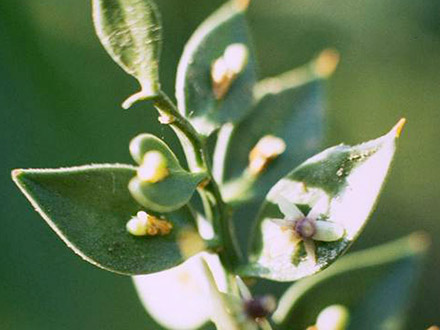Botanical name
Ruscus aculeatus L.
Family
Asparagaceae
Common name
Box holly, Knee holly, Pettigree, Sweet broom, Jew's myrtle
Information about the plant
The prickly butcher's broom is native to the Mediterranean and North Africa, extending to Asia, and is also found on the Atlantic coast of France and England. It grows as an evergreen, drought-loving shrub in thickets and on dry, rocky slopes. The organs that look like leaves are not leaves but leaf-like, widened side shoots (phylloclades), 1.5 to 2.5 cm long. The leaves themselves are inconspicuous scales that fall off easily and are, therefore, not visible.
The small white flowers are clustered roughly in the center of the leaf-like side shoots (phylloclades). When these flowers then ripen into red berries in the middle of the “leaves”, the branches of the butcher's broom become very decorative. This is why they are often used in grave or Advent arrangements during late autumn, and last well into the winter. The phylloclades are leathery, hard, and end in a sharp point that can easily cause an injury. This characteristic has earned the plant the name of “butcher's broom”, reinforced by the prefix in its German name “stinging”. This is also expressed in the species epithet aculeatus, derived from the Latin 'aculeus' (= spine), aculeatus, therefore, meaning “spiny”. In English, the plant is called "butcher's broom" because, in Italy, butchers used to clear their chopping blocks with brooms made of butcher's broom.
Medicinally used parts of plants (herbal drug)
The dried underground parts are used, consisting of the rhizomes with attached roots. They are harvested in late summer.
The commercially available drug comes from Mediterranean countries.
Constituents of the herbal drug
Butcher's broom rhizome contains steroid saponins. The aglycone extracted from it is sold under the name of "ruscogenins". In addition, it contains phytosterols and triterpenes.
Quality of the drug
The quality of butcher's broom rhizome (Rusci rhizoma) is specified in the European Pharmacopoeia (Ph. Eur.).
Medical applications
Recognised medical use
The HMPC has classified butcher's broom rhizome as a traditional herbal medicinal product (see “Traditional use”).
ESCOP: for the supportive treatment of symptoms of chronic venous insufficiency (CVI), such as painful, tired, and heavy legs, as well as tingling and swelling of the legs. Supportive for symptoms of hemorrhoids (itching, burning).
Traditional use
Butcher's broom rootstock has been classified by the HMPC as a traditional herbal medicinal product (Article 16a of Directive 2001/83/EC). Based upon long-standing use, butcher's broom rhizome can be used to relieve discomfort and heaviness in the legs associated with mild venous circulatory disorders and to relieve itching and burning in the case of hemorrhoids.
Herbal drug preparations in finished dosage forms
Dry extracts in capsules and tablets
Dosage
Finished medicinal products: To ensure efficacy, butcher's broom rhizome should be taken in the form of medicinal products with a defined active ingredient content (quantified extract) or preparations adjusted to ruscogenins. The dosage can be found in the patient information leaflet.
Preparation of a tea
The effective dose for trating chronic venous insufficiency (CVI) is not achieved with a tea preparation of butcher's broom rhizome.
Notes
Medical advice must be sought in the presence of skin inflammation or subcutaneous hardening, ulcers, sudden swelling of the legs, or in the presence of cardiac or renal insufficiency.
No safety studies are available for use during pregnancy and lactation. The use in children and adolescents under the age of 18 is not recommended due to a lack of evidence.
Side effects
None known.
Interactions
None known.
References
Herbal drug monographs
Further literature
Commentary on the European Pharmacopoeia (Butcher's broom rhizome, No. 1847)


